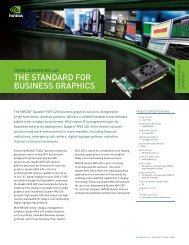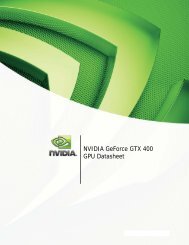Tegra 4 Whitepaper - Nvidia
Tegra 4 Whitepaper - Nvidia
Tegra 4 Whitepaper - Nvidia
- No tags were found...
Create successful ePaper yourself
Turn your PDF publications into a flip-book with our unique Google optimized e-Paper software.
P a g e | 4growing in the industry today. Visually rich PC and console games such as Max Payne andGrand Theft Auto III are now available on mobile devices.High quality, high resolution retina displays (with resolutions high enough that the human eyecannot discern individual pixels at normal viewing distances) are now being used in variousmobile devices. Such high resolution displays require fast GPUs to deliver smooth UIinteractions, fast Web page rendering, snappy high-res photo manipulation, and of course highquality 3D gaming. Similarly, connecting a smartphone or tablet to an external high-resolution4K screen absolutely requires a powerful GPU.With two decades of GPU industry leadership, the mobile GPU in the NVIDIA ® <strong>Tegra</strong> ® 4 Familyof mobile processors is architected to deliver the performance demanded by console-classmobile games, modern user interfaces, and high-resolution displays, while reducing powerconsumption to fall within mobile power budgets. You will see that the <strong>Tegra</strong> 4 processor is alsothe most architecturally efficient GPU subsystem in any mobile SoC today. Next, we’ll take adetailed look at the high performance GPU implemented in the <strong>Tegra</strong> 4 processor.<strong>Tegra</strong> 4 Family GPU Features and ArchitectureThe <strong>Tegra</strong> 4 processor’s GPU accelerates both 2D and 3D rendering. Although 2D rendering isoften considered a “given” nowadays, it’s critically important to the user experience. The 2Dengine of the <strong>Tegra</strong> 4 processor’s GPU provides all the relevant low-level 2D compositionfunctionality, including alpha-blending, line drawing, video scaling, BitBLT, color spaceconversion, and screen rotations. Working in concert with the display subsystem and videodecoder units, the GPU also helps support 4K video output to high-end 4K video display.The 3D engine is fully programmable, and includes high-performance geometry and pixelprocessing capability enabling advanced 3D user interfaces and console-quality gamingexperiences. The GPU also accelerates Flash processing in Web pages and GPGPU (GeneralPurpose GPU) computing, as used in NVIDIA’s new Computational Photography Engine,NVIDIA Chimera architecture, that implements near-real-time HDR photo and videophotography, HDR Panoramic image processing, and “Tap-to-Track” objecting tracking.As shown in the <strong>Tegra</strong> 4 family diagram in Figure 1 below, <strong>Tegra</strong> 4 processor includes a 72core GPU subsystem. The <strong>Tegra</strong> 4’s processor’s GPU has 6x the number of shader processingcores of <strong>Tegra</strong> 3 processor, which translates to roughly 3-4x delivered game performance andsometimes even higher. The NVIDIA <strong>Tegra</strong> 4i processor uses the same GPU architecture asthe <strong>Tegra</strong> 4 processor, but a 60 core variant instead of 72 cores. Even at 60 cores it delivers anastounding amount of graphics performance for mainstream smartphone devices.NVIDIA <strong>Tegra</strong> 4 GPU Architecture February 2013
















